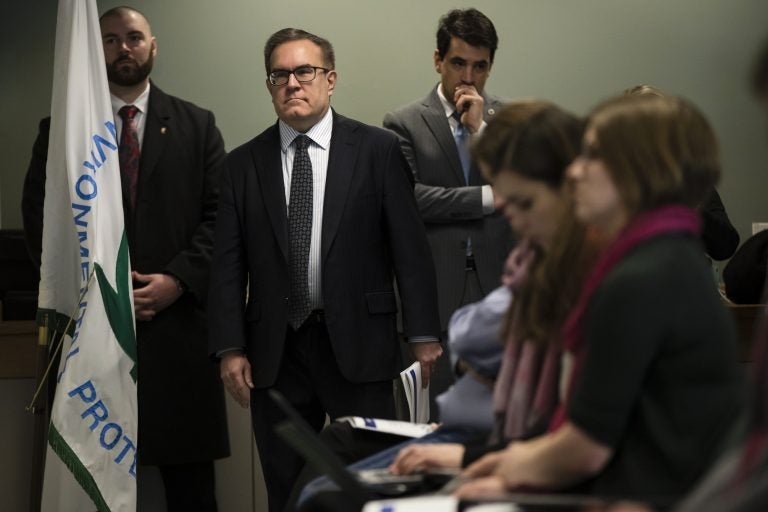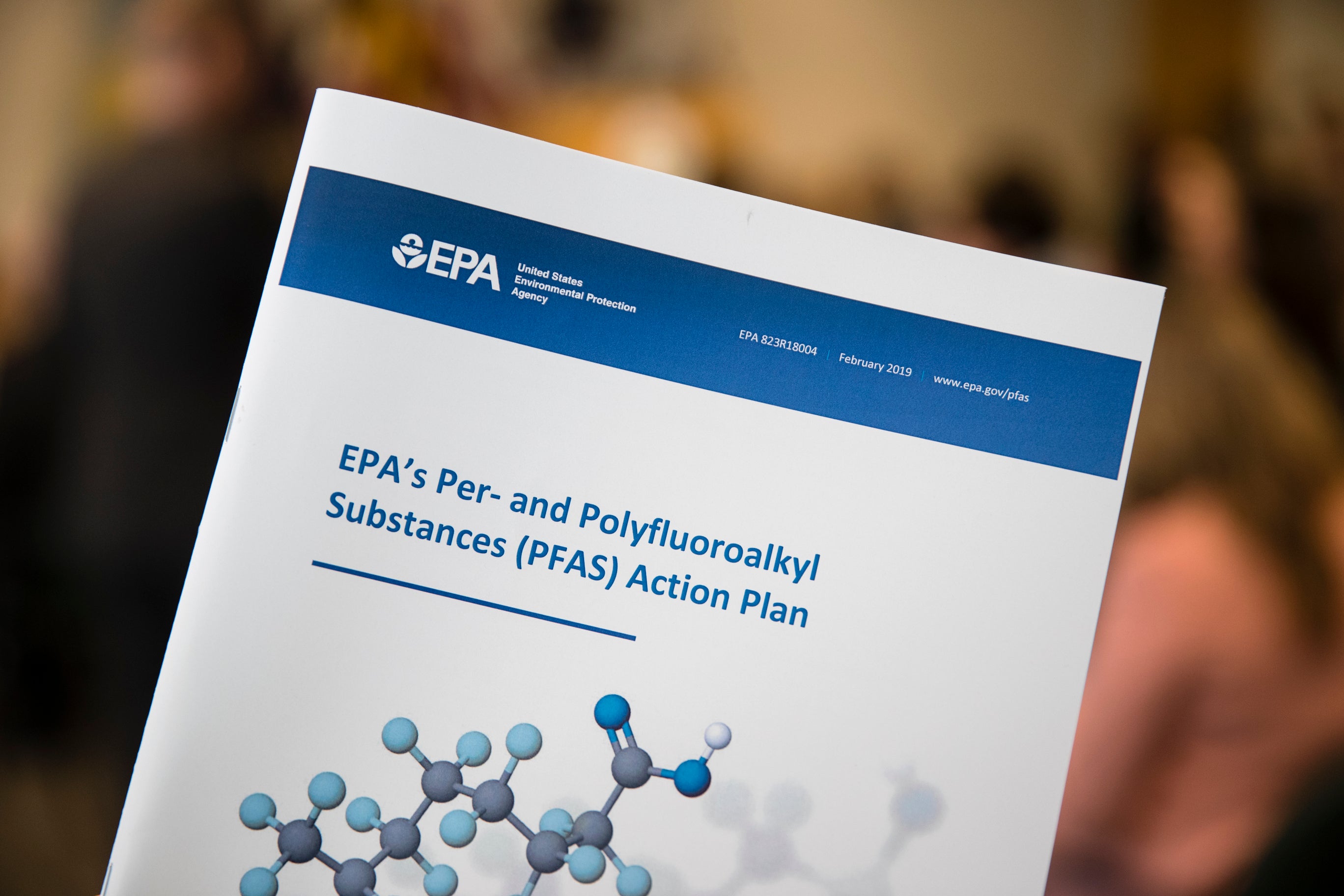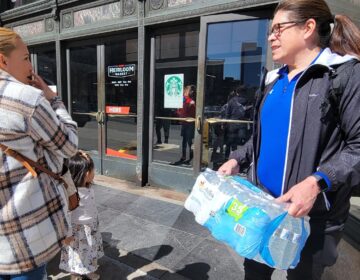EPA to propose limits for PFOA and PFOS, chemicals contaminating soil and water
EPA says it will propose health standards for two chemicals contaminating soil and drinking water. Critics say the EPA is dragging its feet on protecting public health.

Acting Environmental Protection Agency Administrator Andrew Wheeler walks to a podium a news conference in Philadelphia, Thursday, Feb. 14, 2019. The EPA is expected to announced a plan for dealing with a class of long-lasting chemical contaminants amid complaints from members of Congress and environmentalists that it's not moved aggressively enough to regulate them. (Matt Rourke/AP Photo)
Updated: 3:34 p.m. EST
—
The EPA said Thursday that it will start the long process to set limits of PFOA and PFOS in drinking water and soil. The two toxic chemicals, along with others in the PFAS family of chemicals, are linked to cancer and other illnesses. PFAS was widely used at one time, including in the manufacture of nonstick cookware, stain-resistant clothing and firefighting foam. They remain in the environment and are often referred to as “forever chemicals.”
The agency released a long-awaited Action Plan on how to manage contamination by the two chemicals and others in the PFAS family.

EPA Acting Administrator Andrew Wheeler announced the plan at EPA Region 3 headquarters in Philadelphia. Wheeler called the plan “historic” and said the agency will propose a maximum contaminant level (MCL) for the toxic chemicals by the end of this year. Setting an MCL is crucial for regulation, it means that EPA would have enforcement authority under the Safe Drinking Water Act. The agency has not set any MCL’s for new chemicals since 1996.
“It took groundbreaking efforts to develop this plan,” Wheeler said. “This is the first time we have utilized all of our program offices to deal with an emerging chemical of concern.”
Wheeler also said the agency will continue research on similar, unregulated chemicals like another contaminant of “emerging concern” known as GenX.
“Our goal is to close the gap on science as quickly as possible especially as it relates to emerging risks like GenX,” said Wheeler.
GenX has been promoted as a replacement for PFOA, which was used to make Teflon.
The decision to begin PFAS regulation under the Safe Drinking Water Act contradicts a recent press report that the EPA had decided not to set national standards for the chemicals. Wheeler said those reports were inaccurate.
The agency says the process is designed to ensure public participation, transparency, and the use of the best available science. Wheeler said the process is not quick.
“None of these processes can be done overnight,” he said,”in order to make sure they stand up in court.”
Residents from the Warminster area living with PFOA and PFAS contamination attended the press conference at EPA Region 3 Headquarters in Center City Philadelphia. They say the agency should act more quickly to regulate the chemical.
Mark Cuker is a member of the Buxmont Coalition for Safer Water and an environmental attorney. Cuker says he wants an MCL set for “non-detect” — meaning no level of the chemicals would be considered safe.
“There’s just no reason why this couldn’t be done by now,” said Cuker. “So here’s an analogy, you’re drowning, the lifeguard says ‘I’m coming.’ You’re now going down for the third time. The lifeguard is still sitting on the beach saying ‘I’m coming.’”
Currently, the EPA has an advisory level of 70 parts per trillion for these chemicals, while states like New Jersey and Vermont have moved to set much more stringent levels. In June, another federal agency under the CDC published its own health standards for PFAS and recommended much lower levels for two of the chemicals.
The New Jersey Department of Environmental Protection called the move disappointing.
“The Trump Administration is leaving millions of Americans exposed to harmful chemicals for too long by choosing a drawn-out process that will delay establishing a federal maximum contaminant level (MCL) for PFAS,” the DEP said in a written statement.
On Thursday, Wheeler said he believes 70 ppt is a safe level.
“As we go forward with the MCL we’ll be looking to see if lower levels are required according to where the science directs us.”
As part of its plan, the EPA has also begun the process of listing PFOA and PFOS as hazardous substances under the Superfund law. That will help communities deal with existing contamination and recover cleanup costs from responsible parties.
PFOA and PFOS contamination in Montgomery and Bucks counties near two former military facilities led to water pollution in Horsham, Warrington, and Warminster.
The EPA says it will also publish recommendations “very soon” on cleaning up the two chemicals in groundwater, an important source of drinking water for many communities.

The plan will include expanded monitoring for PFAS and will add the chemicals to its Unregulated Contaminant Monitoring Program. The agency’s latest testing showed that about 1 percent of public water systems had at least one sample with PFOA and PFOS concentrations greater than 70 parts per trillion, the agency’s current health advisory limit for the chemicals.
EPA says it plans to step up its research into the human health and ecological effects of PFAS, and will look at contamination pathways and the costs of curbing the substances, with special attention to emerging replacements for PFAS chemicals, notably GenX.
It will also develop a “communication toolbox” on PFAS that state and local governments can use to communicate with the public on responding to the contamination.
“We owe it to the American public to be able to explain in very simple and easy to understand terms what are the risks that they face in their daily lives,” said Dave Ross, the assistant administrator for water at the EPA, who spoke to reporters on a conference call. “We are stepping up to provide the leadership that the public needs and deserves.”
Critics have frequently accused the EPA of failing to take a leadership role in curbing PFAS. Some state officials have called on the agency to set national standards for the chemicals, to avoid what they call a “patchwork” of state regulations.
Asked about the timing of the regulatory process for the two chemicals, Ross said: “We will propose a first step by the end of this year, and we are working as expeditiously as we can to do that.”
Both Ross and Wheeler declined to say what level of MCL would be set for the two chemicals or whether it would be near the EPA’s current health advisory level of 70 parts per trillion, which advocates say is not strict enough to protect public health.
Ross said a decision on what level to propose would be made on the basis of the existing advisory level, advice from a drinking water board, the latest research, and public comment.
“We will develop the standard at the level that science dictates for us,” he said.
Environmental Working Group, a national advocate for curbing PFAS, called the EPA’s plan “a recipe for more contamination.”
EWG said the plan would not stop the introduction of new PFAS chemicals, clean up drinking water supplies, or alert the public to PFAS pollution.
It accused the EPA of “continued foot-dragging” in protecting the public from the chemicals.
“It’s shameful that the EPA has taken two decades to produce a plan that allows increased exposure to compounds whose makers have used the American people as guinea pigs and, with the EPA’s complicity, covered it up,” said Scott Faber, EWG’s senior vice president for government affairs, in a statement.
Delaware Riverkeeper Network, a Pennsylvania environmental group, also slammed the EPA’s plan, which it said would provide no immediate relief for communities such as those in Pennsylvania and New Jersey that are dealing with water and soil contaminated with PFAS chemicals.
“Essentially, EPA announced they are going to study further whether or not they will consider setting federal MCLs, a ‘plan’ that lacks any sense of urgency and offers no timely relief to people exposed to these highly toxic compounds in their water,” DRN said in a statement.
DRN, a longtime advocate for tighter curbs on the chemicals, said there is no reason for the EPA not to act immediately to set MCLs given voluminous scientific evidence of PFAS’ risks to public health.
“Decades have passed since EPA began looking at these contaminants, which begs the question why they need more time to decide on MCLs,” DRN said in a statement.
U.S. Sen. Tom Carper (D-Del.) called the plan “insufficiently protective” and accused the EPA of lacking urgency on PFAS protection. He noted that former EPA Administrator Scott Pruitt had committed to publishing a national management plan on the chemicals almost a year ago.
“It has taken the EPA nearly a year just to kick the can even further down the road,” Carper said.
WHYY is your source for fact-based, in-depth journalism and information. As a nonprofit organization, we rely on financial support from readers like you. Please give today.




